Abstract
During the past 11 years, 31 patients with major juxtahepatic venous injuries were treated with the atriocaval shunt. Penetrating injuries occurred in 27 patients (87%), and injuries from blunt trauma occurred in four patients. Shock was present on admission in 28 patients (90%). Resuscitative thoracotomy for cardiovascular collapse was required in 13 patients (42%). Juxtahepatic venous injuries included the vena cava in 23 patients (74%) and the hepatic veins alone in five patients (16%). One patient had an isolated portal venous injury, and two patients died before their vascular injuries could be delineated. Technical problems related to the shunt occurred in seven patients. Most were related to delays in placement or problems encountered in obtaining vascular control of the suprarenal vena cava. Major hepatic resection was performed in 11 patients (35%). Twenty-five patients died of their injuries. No patient survived who required resuscitative thoracotomy, hepatic resection, or when technical problems with the shunt occurred. Six patients (19%) survived and were discharged from the hospital. All sustained gunshot wounds to the retro-hepatic vena cava. Four of the six survivors had serious postoperative complications, but none were related to the shunt. Major juxtahepatic venous injuries are highly lethal. The atriocaval shunt will permit the salvage of some patients where other methods are not possible. Avoidance of delay and alternative shunting techniques that eliminate difficult maneuvers may improve survival in the future.
Full text
PDF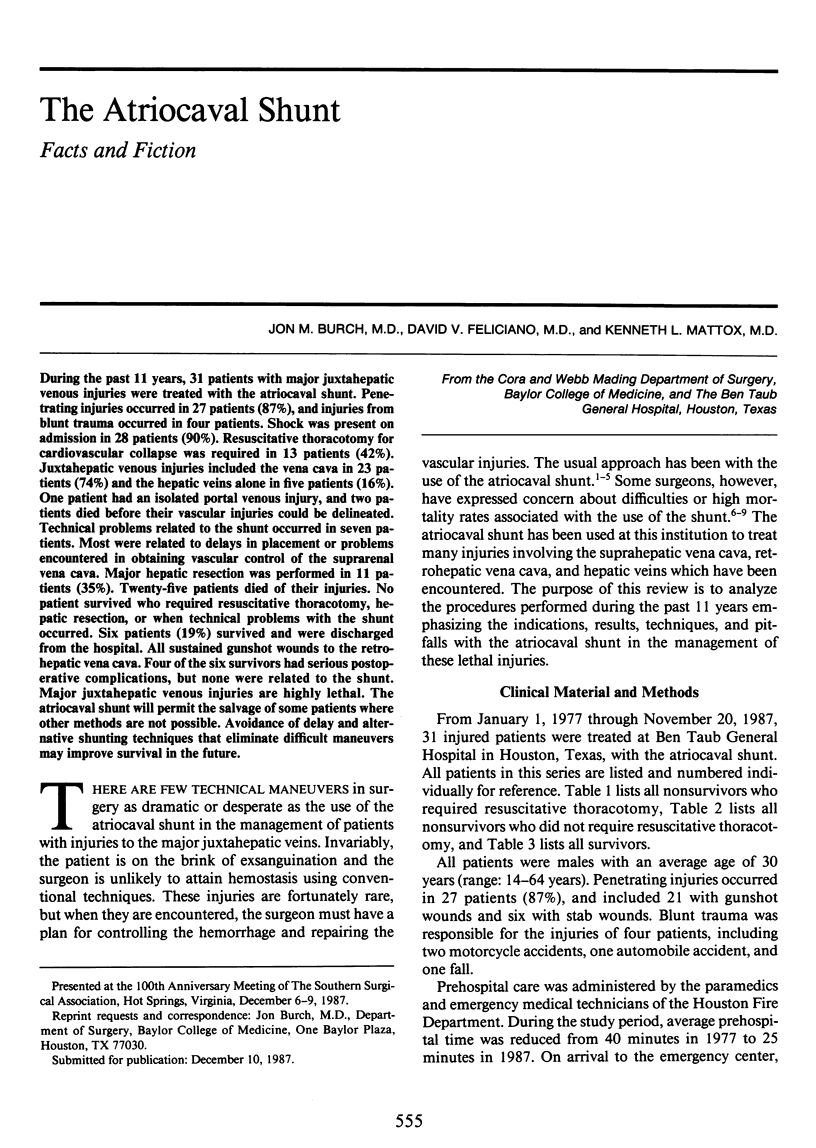
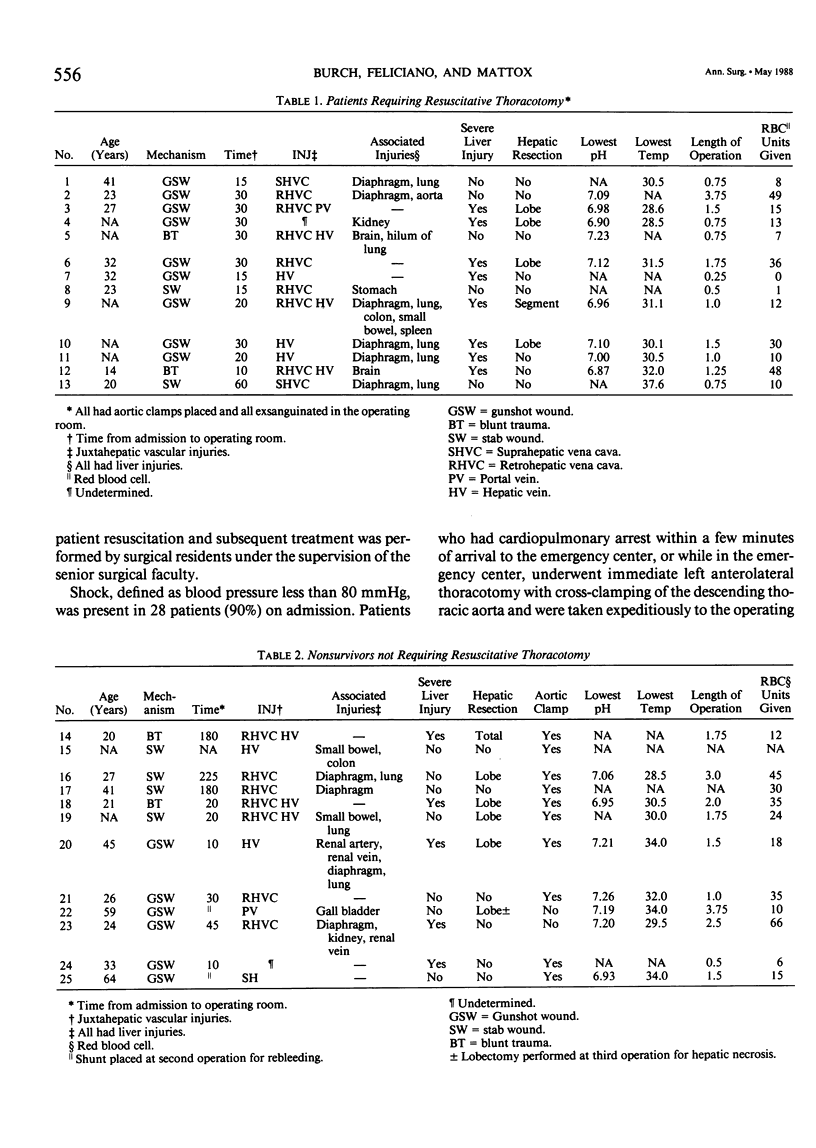
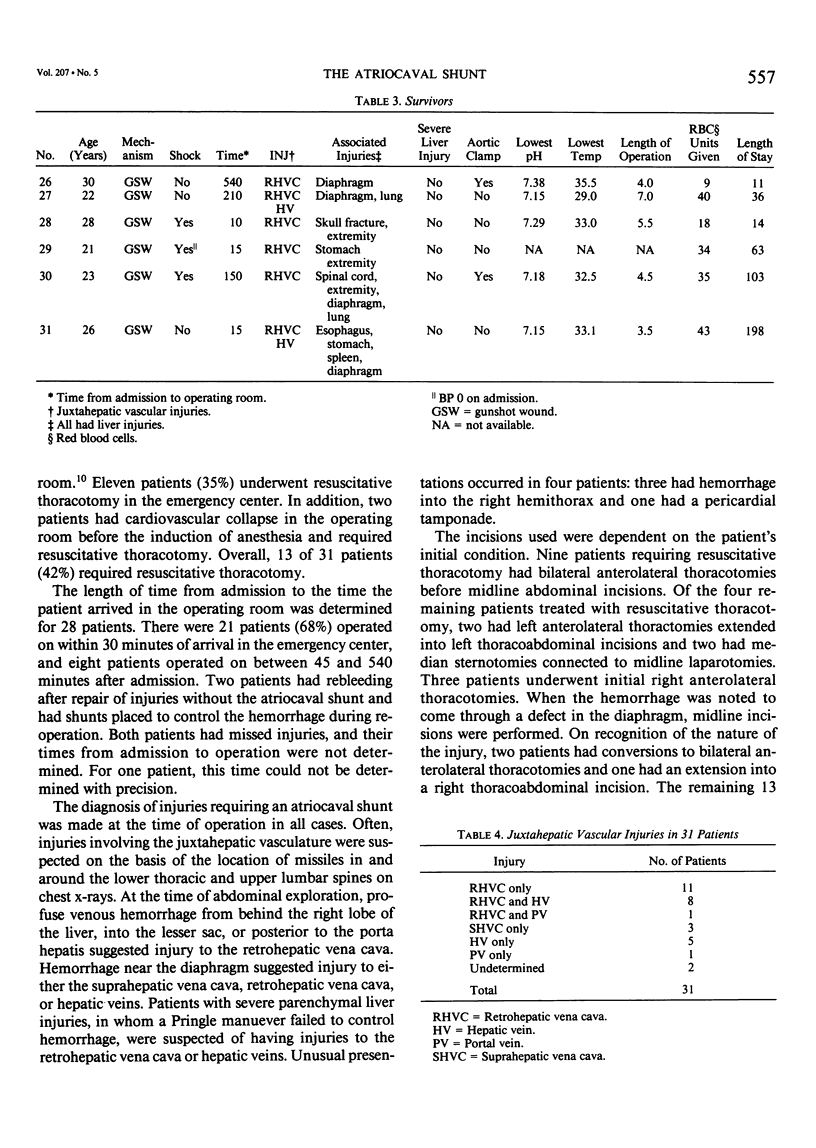
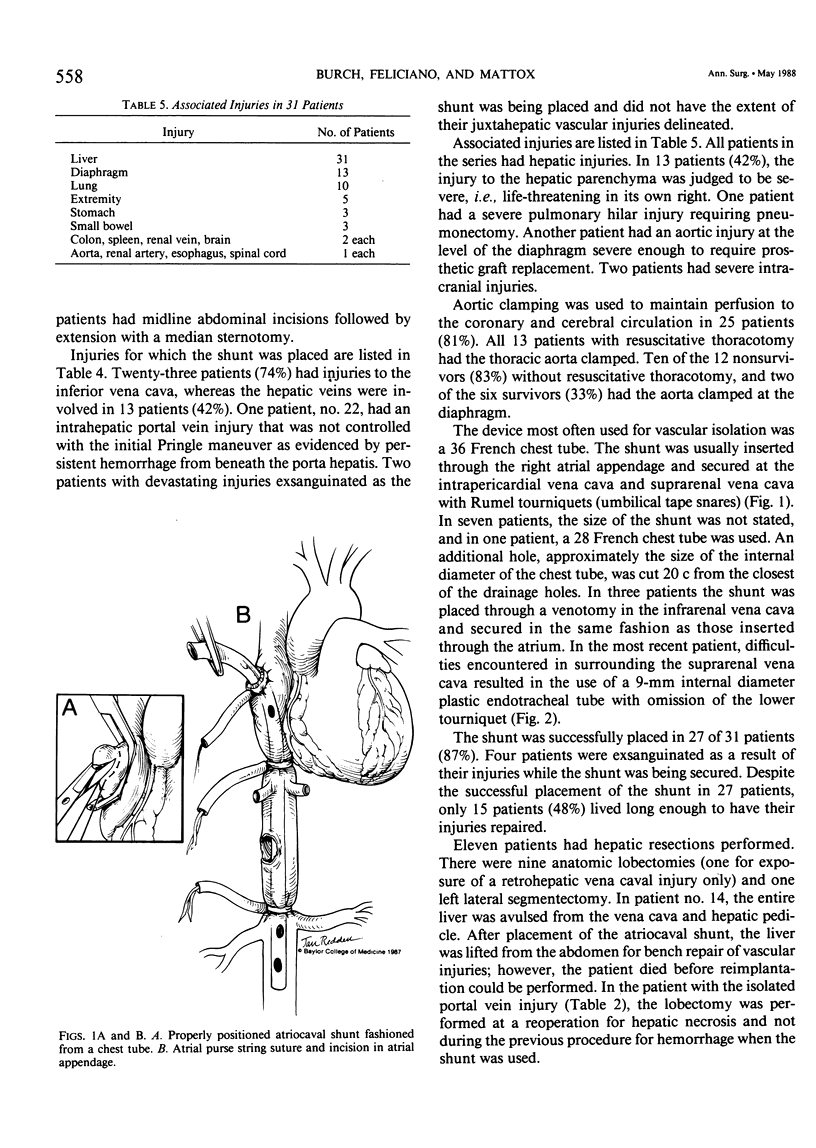
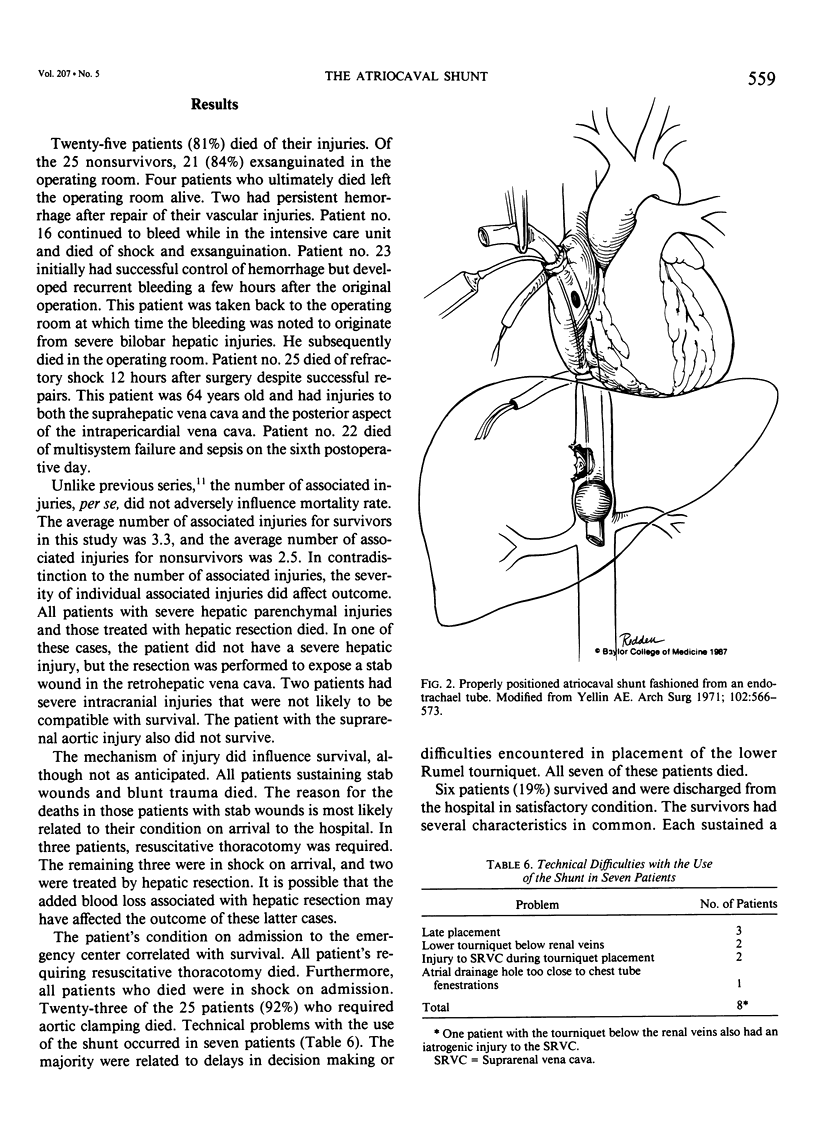
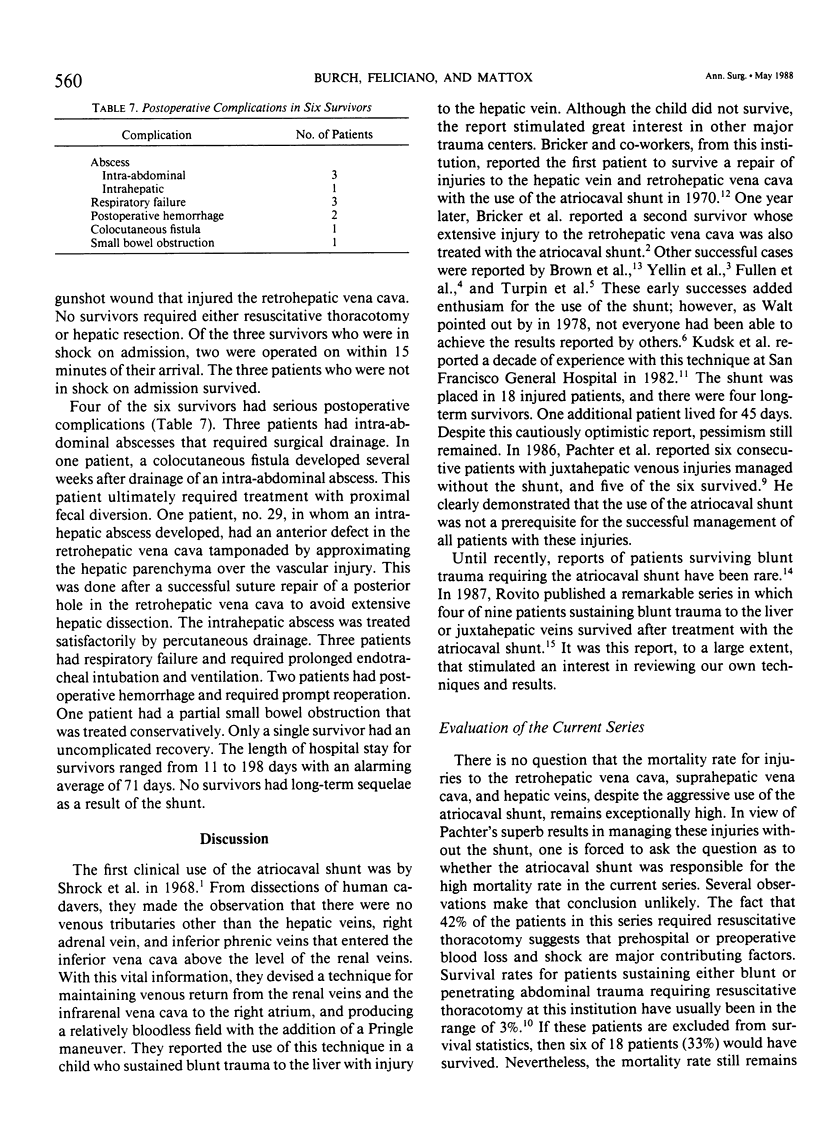
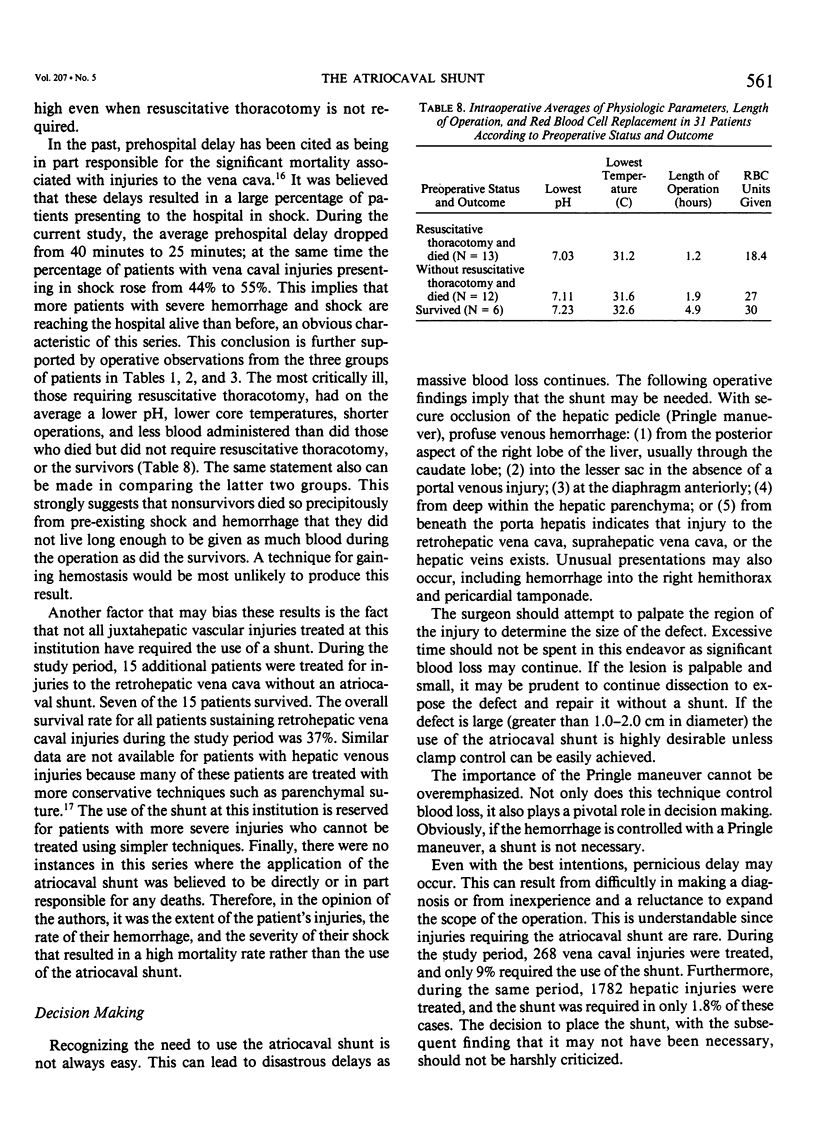
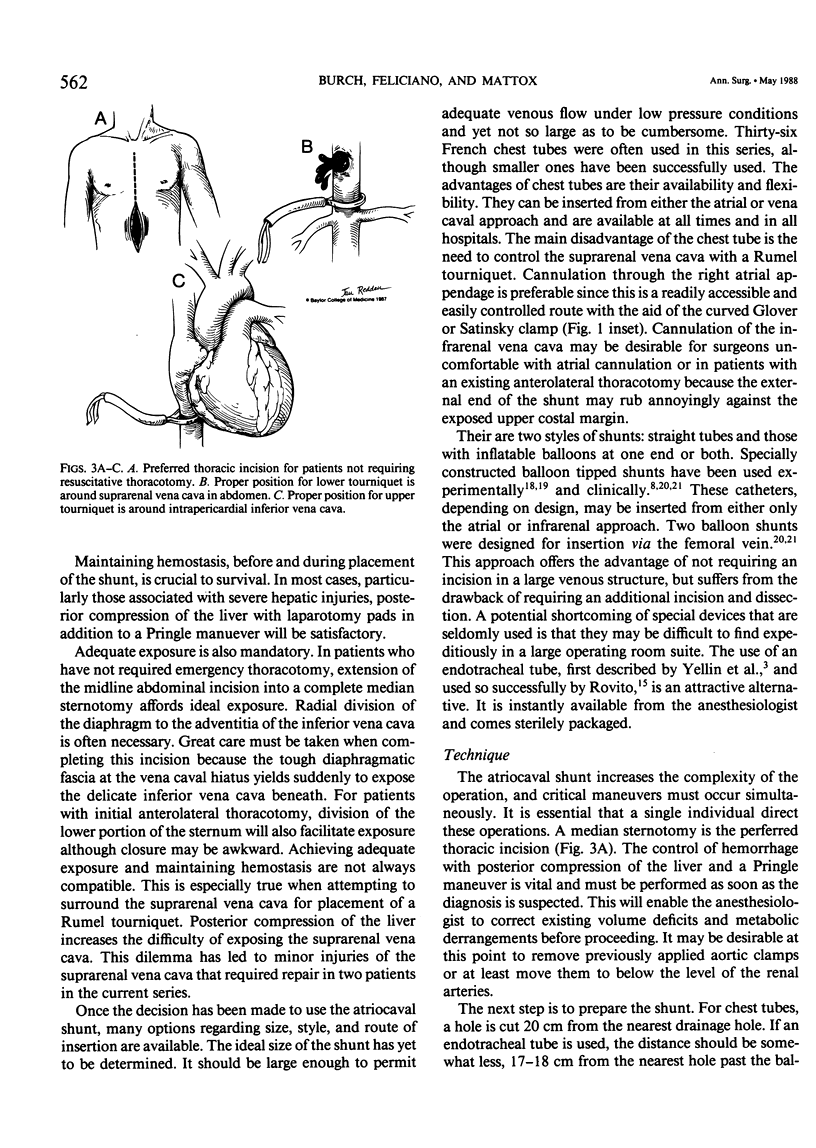
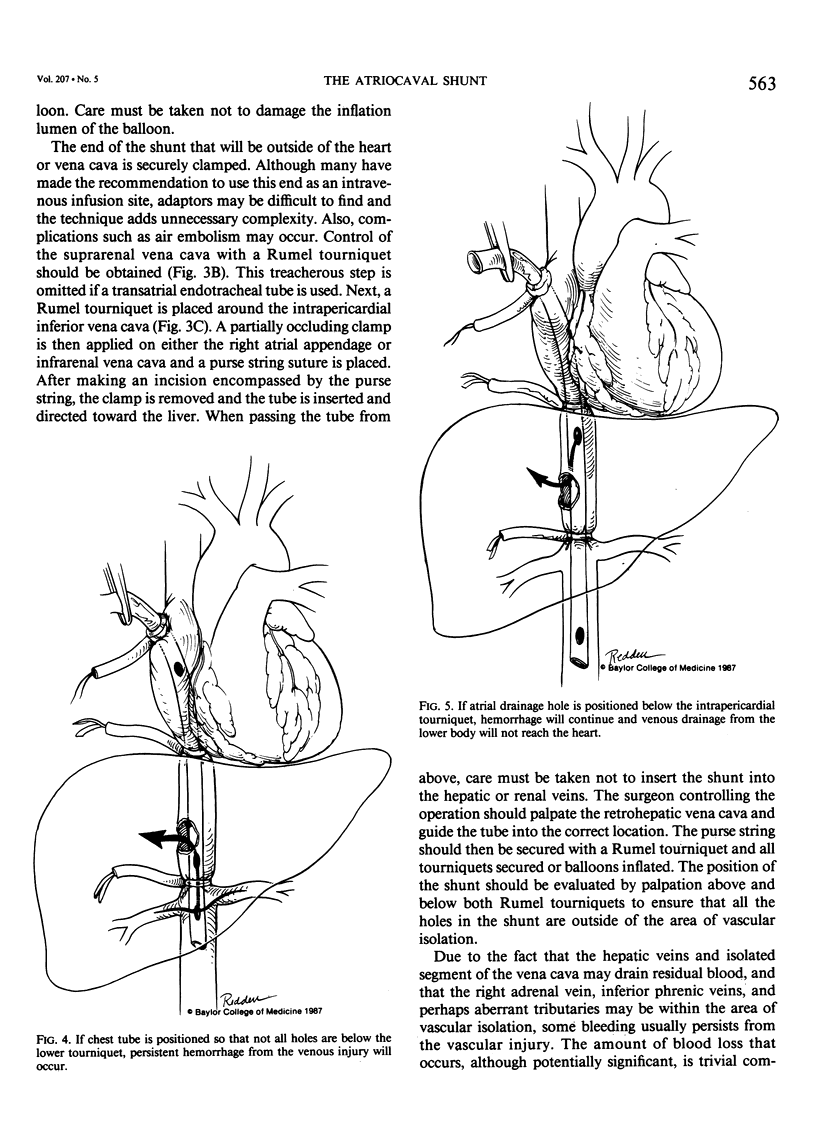
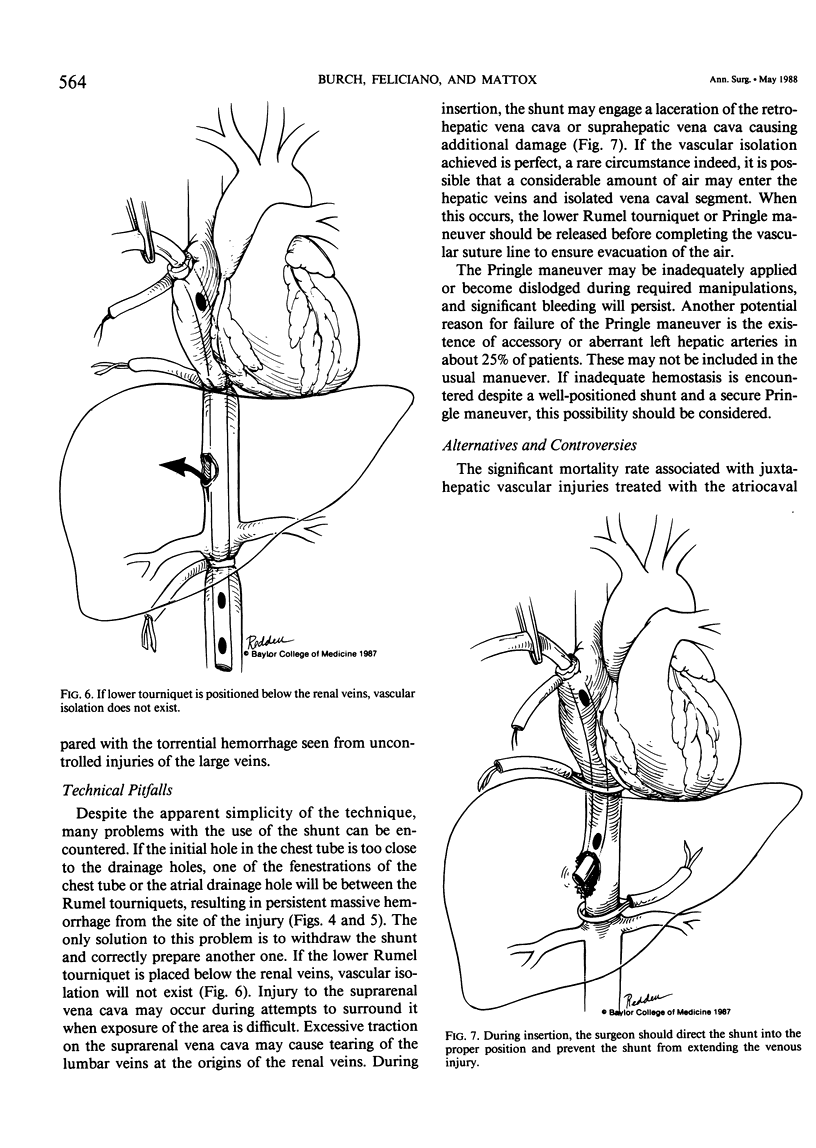
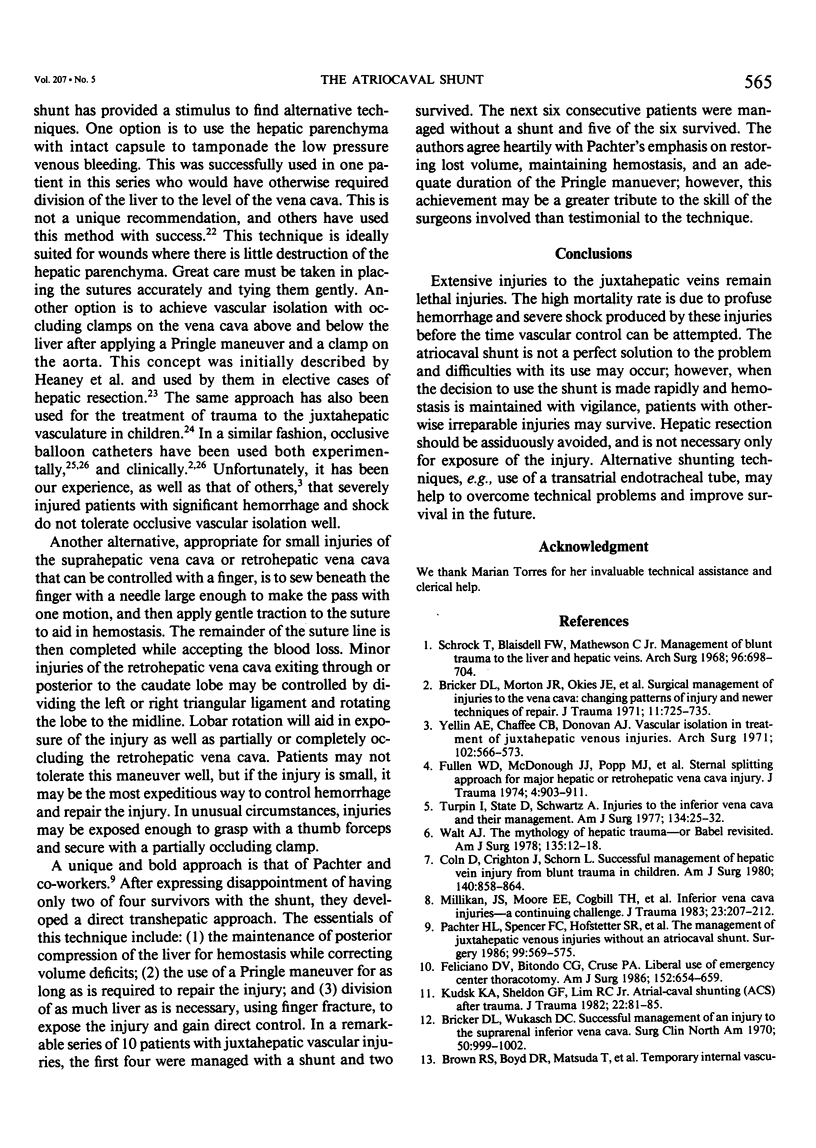
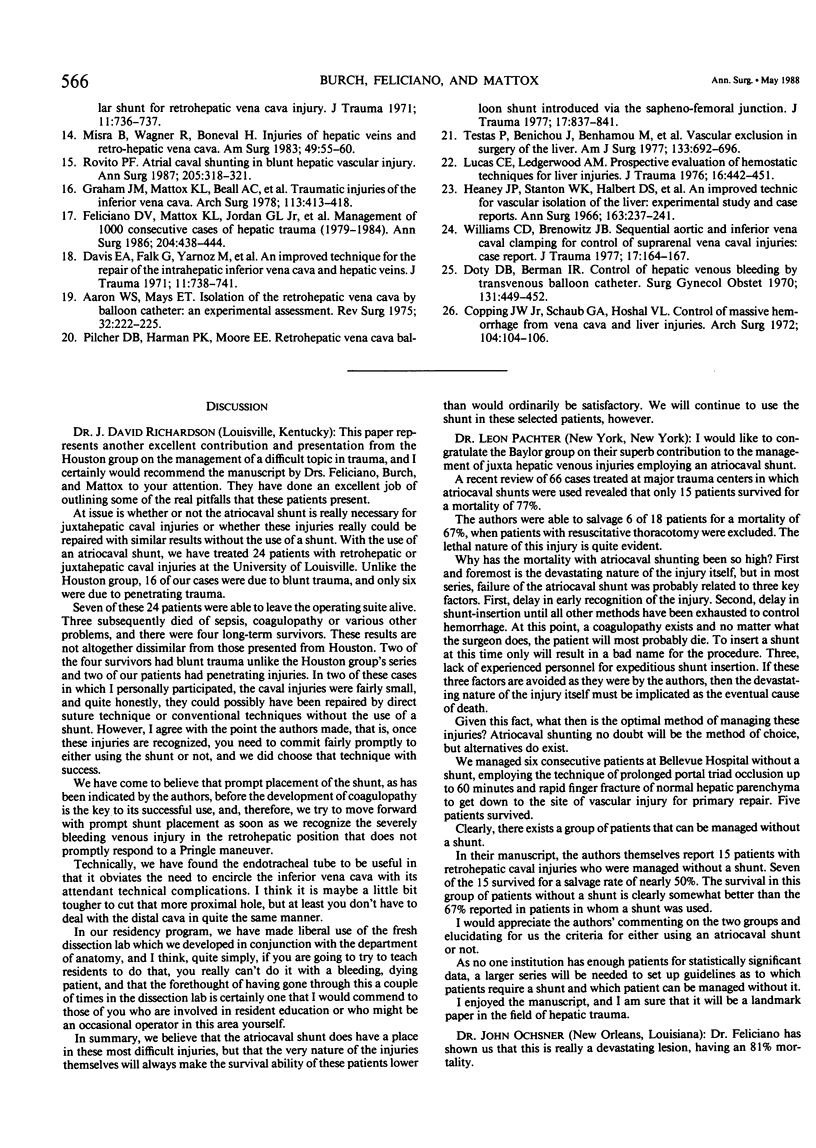
Selected References
These references are in PubMed. This may not be the complete list of references from this article.
- Aaron W. S., Mays E. T. Isolation of the retrohepatic vena cava by balloon catheter: an experimental assessment. Rev Surg. 1975 May-Jun;32(3):222–225. [PubMed] [Google Scholar]
- Bricker D. L., Morton J. R., Okies J. E., Beall A. C., Jr Surgical management of injuries to the vena cava: changing patterns of injury and newer techniques of repair. J Trauma. 1971 Sep;11(9):725–735. doi: 10.1097/00005373-197109000-00001. [DOI] [PubMed] [Google Scholar]
- Bricker D. L., Wukasch D. C. Successful management of an injury to the suprarenal inferior vena cava. Surg Clin North Am. 1970 Oct;50(5):999–1002. doi: 10.1016/s0039-6109(16)39234-9. [DOI] [PubMed] [Google Scholar]
- Brown R. S., Boyd D. R., Matsuda T., Lowe R. J. Temporary internal vascular shunt for retrohepatic vena cava injury. J Trauma. 1971 Sep;11(9):736–737. doi: 10.1097/00005373-197109000-00002. [DOI] [PubMed] [Google Scholar]
- Coln D., Crighton J., Schorn L. Successful management of hepatic vein injury from blunt trauma in children. Am J Surg. 1980 Dec;140(6):858–864. doi: 10.1016/0002-9610(80)90132-4. [DOI] [PubMed] [Google Scholar]
- Copping J. W., Jr, Schaub G. A., Hoshal V. L., Jr Control of massive hemorrhage from vena cava and liver injuries. A simplified technique. Arch Surg. 1972 Jan;104(1):104–106. doi: 10.1001/archsurg.1972.04180010098026. [DOI] [PubMed] [Google Scholar]
- Davis E. A., Falk G., Yarnoz M., LeVeen H. H. An improved technique for the repair of the intrahepatic inferior vena cava and hepatic veins. J Trauma. 1971 Sep;11(9):738–741. doi: 10.1097/00005373-197109000-00003. [DOI] [PubMed] [Google Scholar]
- Doty D. B., Berman I. R. Control of hepatic venous bleeding by transvenous balloon catheter. Surg Gynecol Obstet. 1970 Sep;131(3):449–452. [PubMed] [Google Scholar]
- Feliciano D. V., Bitondo C. G., Cruse P. A., Mattox K. L., Burch J. M., Beall A. C., Jr, Jordan G. L., Jr Liberal use of emergency center thoracotomy. Am J Surg. 1986 Dec;152(6):654–659. doi: 10.1016/0002-9610(86)90443-5. [DOI] [PubMed] [Google Scholar]
- Feliciano D. V., Mattox K. L., Jordan G. L., Jr, Burch J. M., Bitondo C. G., Cruse P. A. Management of 1000 consecutive cases of hepatic trauma (1979-1984). Ann Surg. 1986 Oct;204(4):438–445. doi: 10.1097/00000658-198610000-00012. [DOI] [PMC free article] [PubMed] [Google Scholar]
- Fullen W. D., McDonough J. J., Popp M. J., Altemeier W. A. Sternal splitting approach for major hepatic or retrohepatic vena cava injury. J Trauma. 1974 Nov;14(11):903–911. doi: 10.1097/00005373-197411000-00001. [DOI] [PubMed] [Google Scholar]
- Graham J. M., Mattox K. L., Beall A. C., Jr, DeBakey M. E. Traumatic injuries of the inferior vena cava. Arch Surg. 1978 Apr;113(4):413–418. doi: 10.1001/archsurg.1978.01370160071011. [DOI] [PubMed] [Google Scholar]
- Heaney J. P., Stanton W. K., Halbert D. S., Seidel J., Vice T. An improved technic for vascular isolation of the liver: experimental study and case reports. Ann Surg. 1966 Feb;163(2):237–241. doi: 10.1097/00000658-196602000-00013. [DOI] [PMC free article] [PubMed] [Google Scholar]
- Kudsk K. A., Sheldon G. F., Lim R. C., Jr Atrial-caval shunting (ACS) after trauma. J Trauma. 1982 Feb;22(2):81–85. doi: 10.1097/00005373-198202000-00001. [DOI] [PubMed] [Google Scholar]
- Lucas C. E., Ledgerwood A. M. Prospective evaluation of hemostatic techniques for liver injuries. J Trauma. 1976 Jun;16(6):442–451. doi: 10.1097/00005373-197606000-00003. [DOI] [PubMed] [Google Scholar]
- Millikan J. S., Moore E. E., Cogbill T. H., Kashuk J. L. Inferior vena cava injuries--a continuing challenge. J Trauma. 1983 Mar;23(3):207–212. doi: 10.1097/00005373-198303000-00005. [DOI] [PubMed] [Google Scholar]
- Misra B., Wagner R., Boneval H. Injuries of hepatic veins and retrohepatic vena cava. Am Surg. 1983 Jan;49(1):55–60. [PubMed] [Google Scholar]
- Pachter H. L., Spencer F. C., Hofstetter S. R., Liang H. C., Coppa G. F. The management of juxtahepatic venous injuries without an atriocaval shunt: preliminary clinical observations. Surgery. 1986 May;99(5):569–575. [PubMed] [Google Scholar]
- Pilcher D. B., Harman P. K., Moore E. E., Jr Retrohepatic vena cava balloon shunt introduced via the sapheno-femoral junction. J Trauma. 1977 Nov;17(11):837–841. doi: 10.1097/00005373-197711000-00003. [DOI] [PubMed] [Google Scholar]
- Rovito P. F. Atrial caval shunting in blunt hepatic vascular injury. Ann Surg. 1987 Mar;205(3):318–321. doi: 10.1097/00000658-198703000-00017. [DOI] [PMC free article] [PubMed] [Google Scholar]
- Schrock T., Blaisdell F. W., Mathewson C., Jr Management of blunt trauma to the liver and hepatic veins. Arch Surg. 1968 May;96(5):698–704. doi: 10.1001/archsurg.1968.01330230006002. [DOI] [PubMed] [Google Scholar]
- Testas P., Bénichou J., Benhamou M., Chanzy M. Vascular exclusion in surgery of the liver: experimental basis, technic, and clinical results. Am J Surg. 1977 Jun;133(6):692–696. doi: 10.1016/0002-9610(77)90155-6. [DOI] [PubMed] [Google Scholar]
- Turpin I., State D., Schwartz A. Injuries to the inferior vena cava and their management. Am J Surg. 1977 Jul;134(1):25–32. doi: 10.1016/0002-9610(77)90279-3. [DOI] [PubMed] [Google Scholar]
- Walt A. J. Founder's lecture: The mythology of hepatic trauma--or Babel revisited. Am J Surg. 1978 Jan;135(1):12–18. doi: 10.1016/0002-9610(78)90003-x. [DOI] [PubMed] [Google Scholar]
- Williams C. D., Brenowitz J. B. Sequential aortic and inferior vena caval clamping for control of suprarenal vena caval injuries: case report. J Trauma. 1977 Feb;17(2):164–167. doi: 10.1097/00005373-197702000-00014. [DOI] [PubMed] [Google Scholar]
- Yellin A. E., Chaffee C. B., Donovan A. J. Vascular isolation in treatment of juxtahepatic venous injuries. Arch Surg. 1971 Jun;102(6):566–573. doi: 10.1001/archsurg.1971.01350060030010. [DOI] [PubMed] [Google Scholar]


